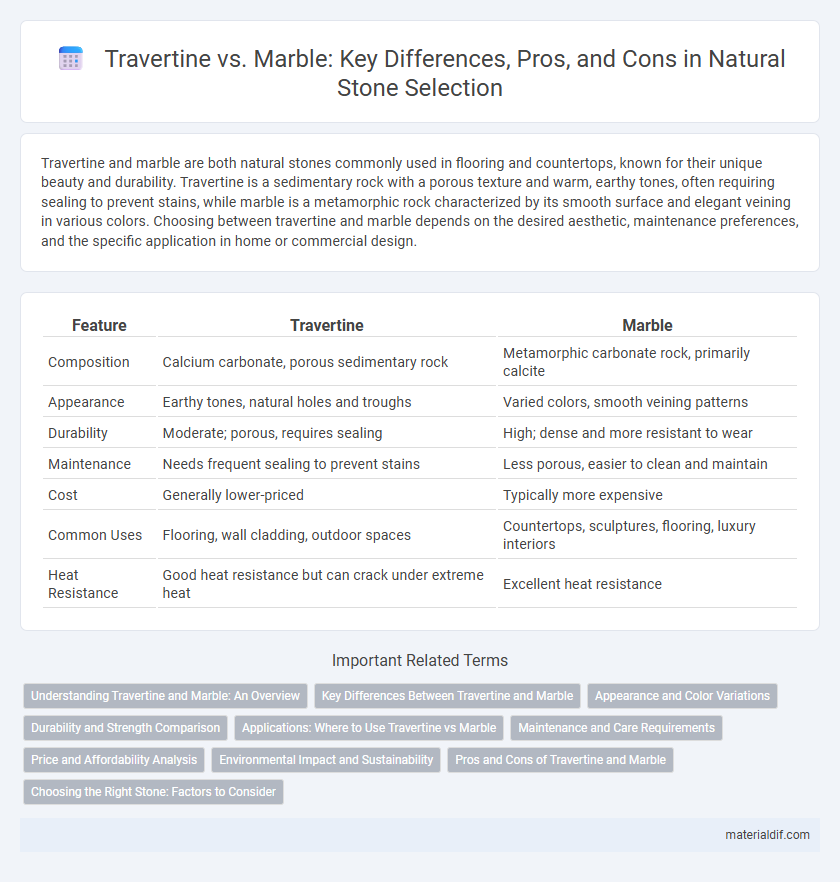Travertine and marble are both natural stones commonly used in flooring and countertops, known for their unique beauty and durability. Travertine is a sedimentary rock with a porous texture and warm, earthy tones, often requiring sealing to prevent stains, while marble is a metamorphic rock characterized by its smooth surface and elegant veining in various colors. Choosing between travertine and marble depends on the desired aesthetic, maintenance preferences, and the specific application in home or commercial design.
Table of Comparison
| Feature | Travertine | Marble |
|---|---|---|
| Composition | Calcium carbonate, porous sedimentary rock | Metamorphic carbonate rock, primarily calcite |
| Appearance | Earthy tones, natural holes and troughs | Varied colors, smooth veining patterns |
| Durability | Moderate; porous, requires sealing | High; dense and more resistant to wear |
| Maintenance | Needs frequent sealing to prevent stains | Less porous, easier to clean and maintain |
| Cost | Generally lower-priced | Typically more expensive |
| Common Uses | Flooring, wall cladding, outdoor spaces | Countertops, sculptures, flooring, luxury interiors |
| Heat Resistance | Good heat resistance but can crack under extreme heat | Excellent heat resistance |
Understanding Travertine and Marble: An Overview
Travertine is a natural sedimentary stone formed by mineral deposits from hot springs, characterized by its porous texture and warm, earthy tones. Marble, a metamorphic rock composed primarily of recrystallized carbonate minerals, is renowned for its smooth surface and distinctive veining patterns. Both stones enhance architectural spaces but offer different durability and maintenance requirements due to their unique geological compositions.
Key Differences Between Travertine and Marble
Travertine and marble differ primarily in their formation, with travertine being a type of limestone formed by mineral springs and characterized by porous, fibrous textures, while marble is a metamorphic rock created from limestone subjected to high pressure and heat, resulting in a denser, more crystalline structure. Travertine typically displays a matte finish with natural holes and troughs, whereas marble offers a polished, smooth surface with distinctive veining patterns. The durability varies; marble is generally more resistant to scratches and heat, making it suitable for high-traffic areas, while travertine requires more maintenance due to its porous nature and vulnerability to staining.
Appearance and Color Variations
Travertine features a porous texture with naturally occurring holes and troughs, often showcasing earthy tones such as beige, cream, and rust. Marble, known for its smooth, polished surface, exhibits a wide range of color variations from classic white with grey veining to deep greens, blacks, and pinks with intricate veining patterns. The distinct appearance of travertine provides a rustic and warm aesthetic, whereas marble offers a luxurious, elegant look with dramatic color contrasts.
Durability and Strength Comparison
Travertine and marble differ significantly in durability and strength, with marble generally exhibiting higher density and hardness, making it more resistant to scratches and wear. Travertine's porous structure makes it more susceptible to chipping and weathering, especially in outdoor applications where moisture exposure is common. For high-traffic areas or surfaces requiring long-term resilience, marble is typically preferred due to its superior structural integrity and ability to withstand heavy use.
Applications: Where to Use Travertine vs Marble
Travertine is ideal for outdoor patios, garden pathways, and pool surrounds due to its natural porous texture and slip-resistant surface. Marble is best suited for indoor applications such as countertops, bathroom vanities, and elegant flooring, where its polished finish and luxurious appearance enhance interior aesthetics. Both stones perform well in flooring, but travertine's durability favors high-traffic exterior spaces while marble excels in decorative, formal interior settings.
Maintenance and Care Requirements
Travertine requires regular sealing to prevent staining and preserve its porous surface, while marble demands more frequent sealing due to its higher susceptibility to etching and scratches. Cleaning travertine involves mild, pH-neutral cleaners to avoid damage, and marble needs gentle, non-acidic products to maintain its polished finish. Both stones benefit from prompt spill cleanup and avoid abrasive materials to extend durability and appearance.
Price and Affordability Analysis
Travertine typically offers a more affordable option compared to marble, with prices ranging from $20 to $40 per square foot, making it suitable for budget-conscious projects. Marble, known for its luxury appeal and unique veining, can cost between $40 and $100 per square foot, significantly impacting overall project expenses. Choosing travertine reduces material costs while maintaining aesthetic value, whereas marble commands a premium price due to its rarity and prestige.
Environmental Impact and Sustainability
Travertine quarrying generally has a lower environmental impact than marble due to its more abundant availability and less intensive extraction process, reducing habitat disruption and energy consumption. Marble production involves higher CO2 emissions from quarrying and processing, contributing to a larger carbon footprint and greater resource depletion. Sustainable practices in travertine use include sourcing from quarries with reclamation programs and utilizing waste material, whereas marble sustainability relies heavily on energy-efficient technologies and responsible quarry management.
Pros and Cons of Travertine and Marble
Travertine offers natural porous texture and warm earth tones, making it ideal for Mediterranean-style interiors but requires regular sealing to prevent staining and erosion. Marble presents a luxurious, polished surface with unique veining patterns, enhancing elegant spaces; however, it is more prone to scratches and etching from acidic substances. Travertine's durability suits high-traffic areas, while marble's maintenance demands suit decorative applications with less wear.
Choosing the Right Stone: Factors to Consider
Travertine offers a porous surface with natural pits and veins, ideal for rustic and earthy designs, while marble features a smooth, polished finish with elegant veining suited for luxurious, classic aesthetics. Consider durability and maintenance: marble is softer and more prone to staining, requiring regular sealing, whereas travertine is more resilient but may need filling for its holes. Climate and usage also play crucial roles, as travertine performs better in warmer, outdoor environments, while marble suits indoor spaces demanding refined elegance.
Travertine vs Marble Infographic

 materialdif.com
materialdif.com